Reports 23-22 and 23-23 | December 2023
The amount of office space the State requires to conduct its work is based, in part, on the extent to which employees work in buildings the State owns or leases. We evaluated the telework and space management practices of 39 executive branch agencies (report 23-22) and all 14 University of Wisconsin (UW) institutions (report 23-23) in 2023. We also assessed risk management practices for information technology (IT) at 10 agencies and 5 UW institutions.
The policies of 26 agencies and 13 UW institutions allowed employees to telework up to five days per week, as of January 1, 2023. Eight agencies and one UW institution allowed less telework.
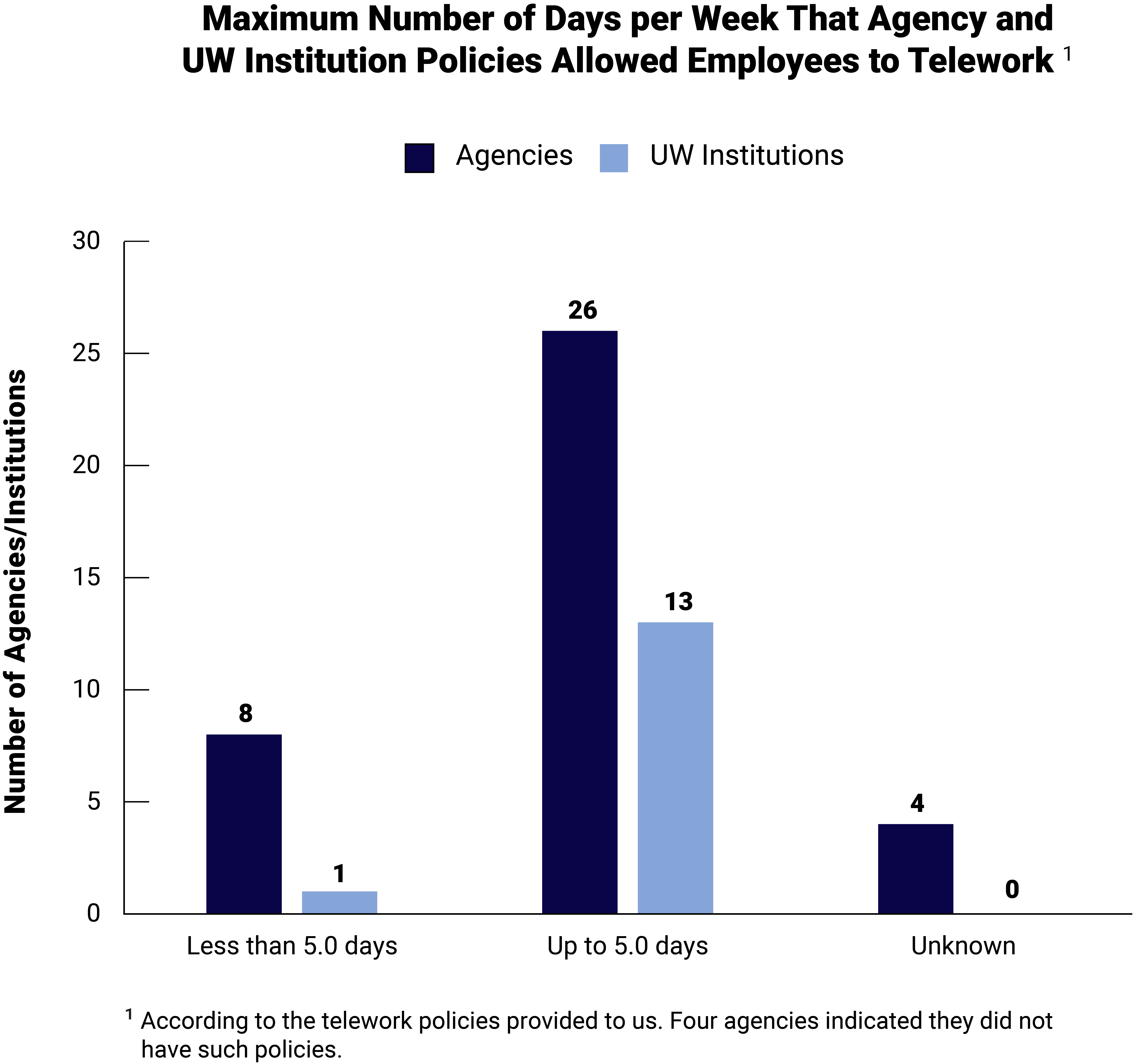
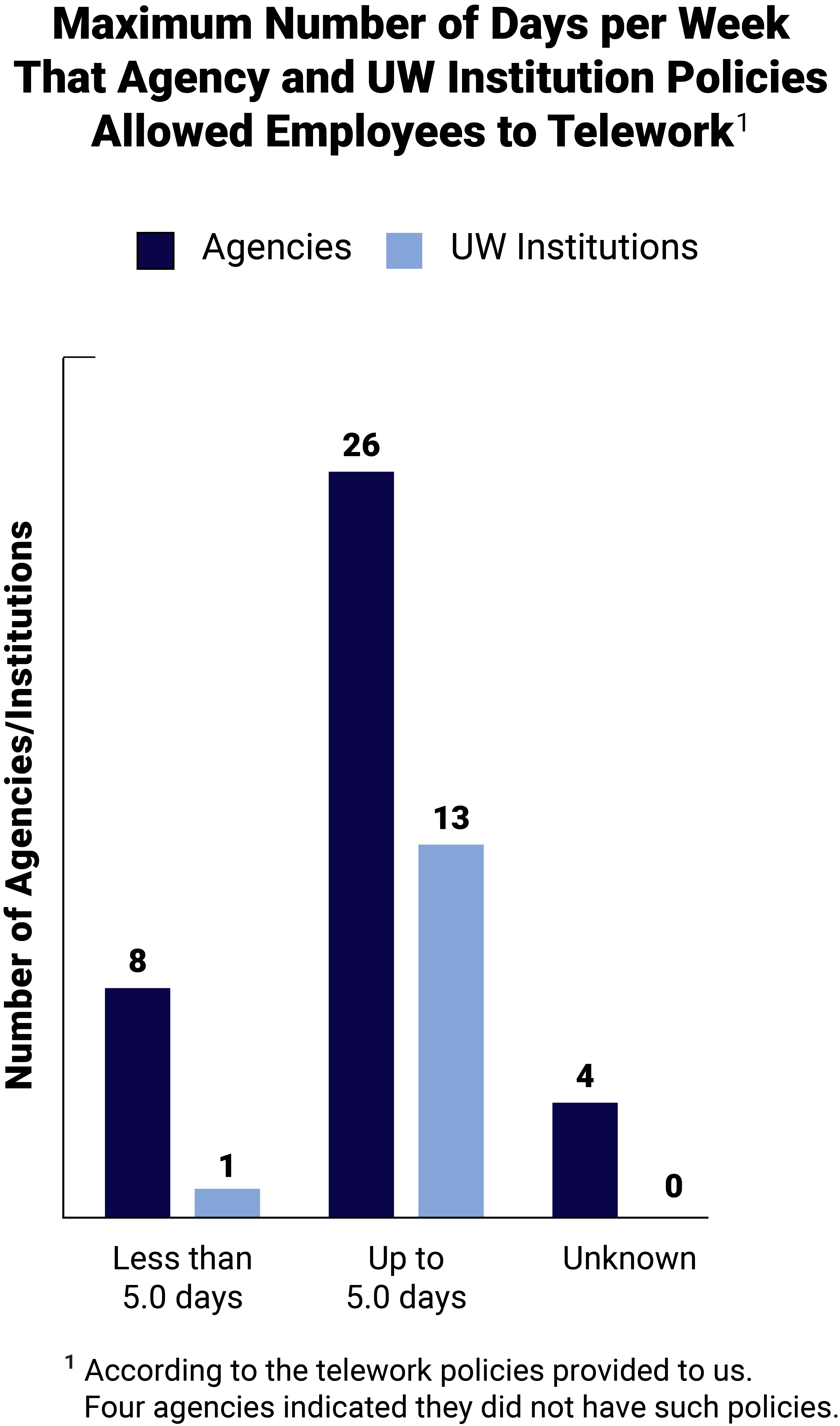
The Department of Administration (DOA) developed the Wisconsin Human Resources Handbook (Handbook), which DOA indicated 35 of the 39 agencies must follow. The Handbook required agencies to implement agreements that specified job schedules and work duties while employees teleworked.
UW System Administration developed telework policies that required all UW institutions, except for UW-Madison, to execute agreements with employees that specified schedules and job duties while employees teleworked. Statutes authorize UW-Madison to develop its own policies. We recommend UW System Administration modify its policies to require UW institutions to consider an employee’s work performance and job characteristics when determining eligibility to telework, and to specify whether employees are permitted to telework outside of the U.S.
We reviewed the January 1, 2023 telework policies and blank agreements provided by agencies and UW institutions in order to determine the extent to which they included the 28 best practices for telework we had identified. We found that the policies and blank agreements for:
- 38 agencies each included, on average, 17.3 of the 28 best practices; and
- 14 UW institutions each included, on average, 22.6 of the 28 best practices.
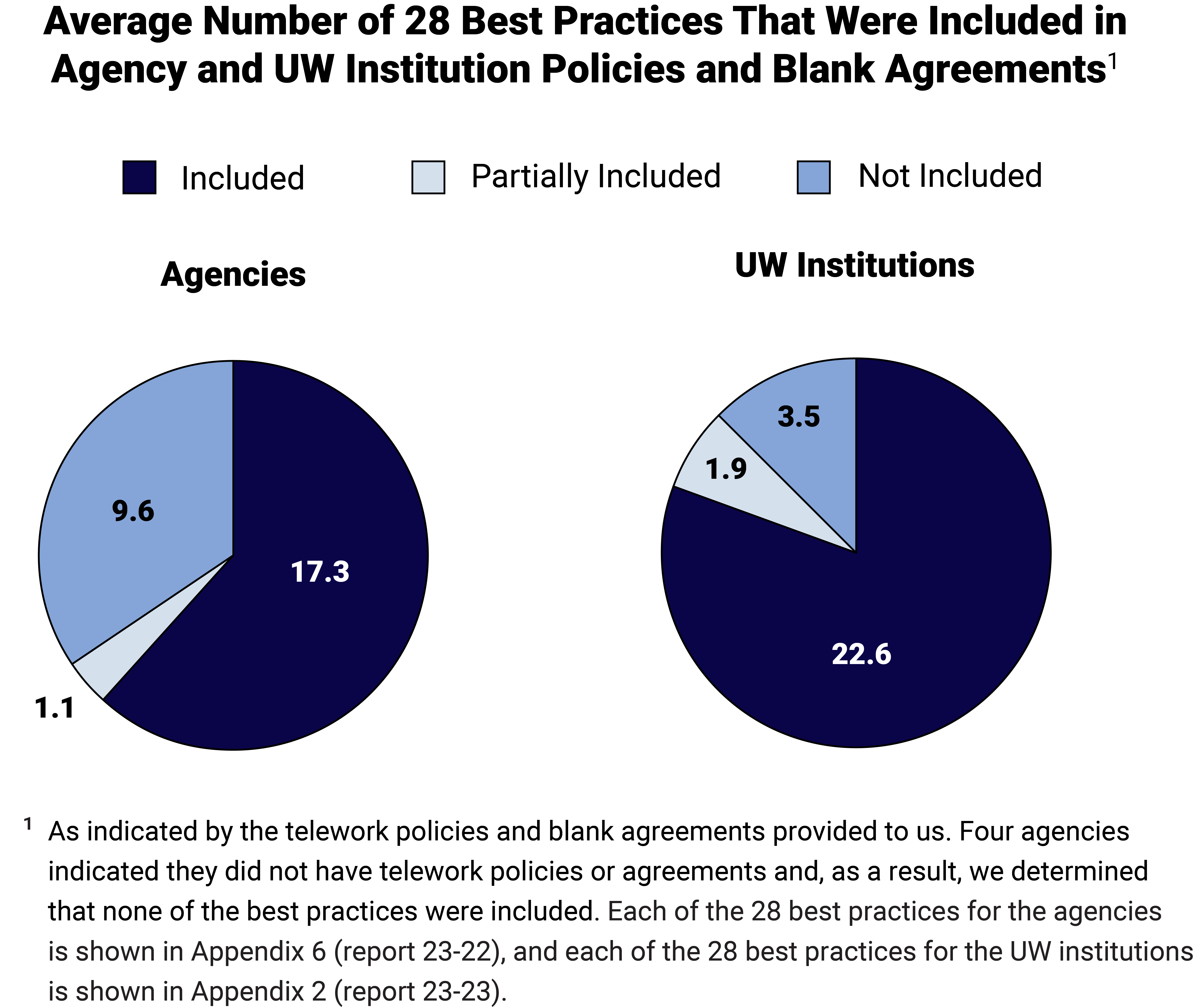
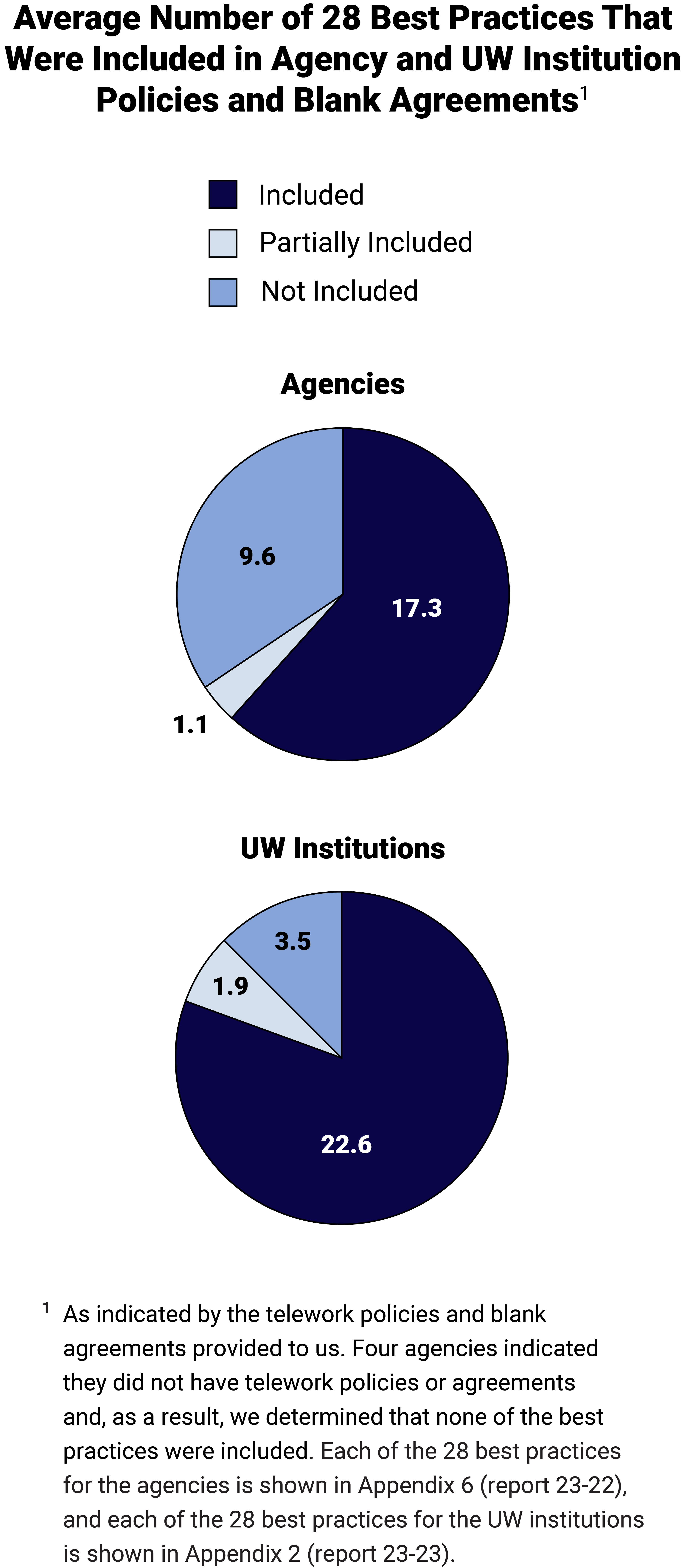
In response to our May 2023 survey:
- 22 of 38 agencies indicated telework somewhat or considerably increases the efficiency of their operations, but 29 agencies indicated they had not assessed in writing within the past year the effects of telework on their operations; and
- 7 of 14 UW institutions indicated telework somewhat or considerably increases the efficiency of their operations. One UW institution indicated it had assessed in writing within the past year the effects of telework on its operations, but it had no written assessment to provide us when we requested this assessment.
In response to our survey, 29 agencies and 12 UW institutions indicated they did not centrally track whether employees worked in the office on a given day.
Some employees may not have agreements, including because they do not telework or are not permitted to telework, such as those who work at correctional institutions. We determined the extent to which employees at selected agencies had agreements that permitted them to telework. We found that:
- On January 1, 2023, 3,667 of 18,657 employees (19.7 percent) at 15 agencies had agreements, including 3,202 employees whose agreements permitted them to telework an average of 2.7 days per week.
- On April 5, 2023, 6,558 of 21,308 noninstructional UW employees (30.8 percent) had agreements, including 6,487 employees whose agreements permitted them to telework an average of 3.0 days per week.
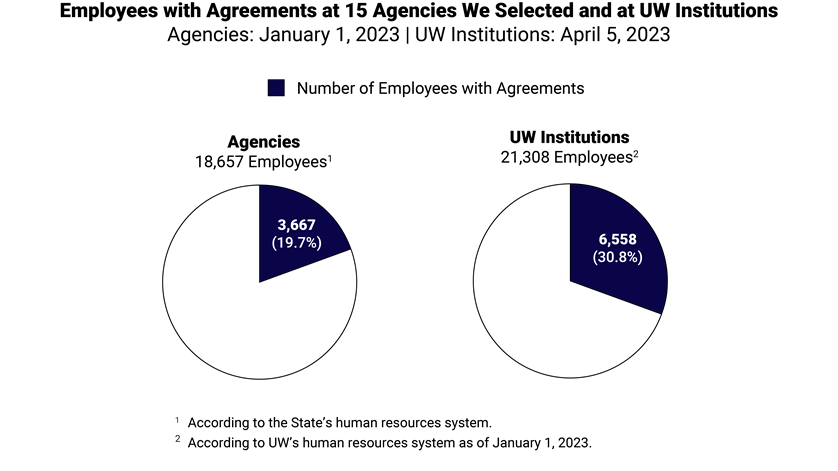
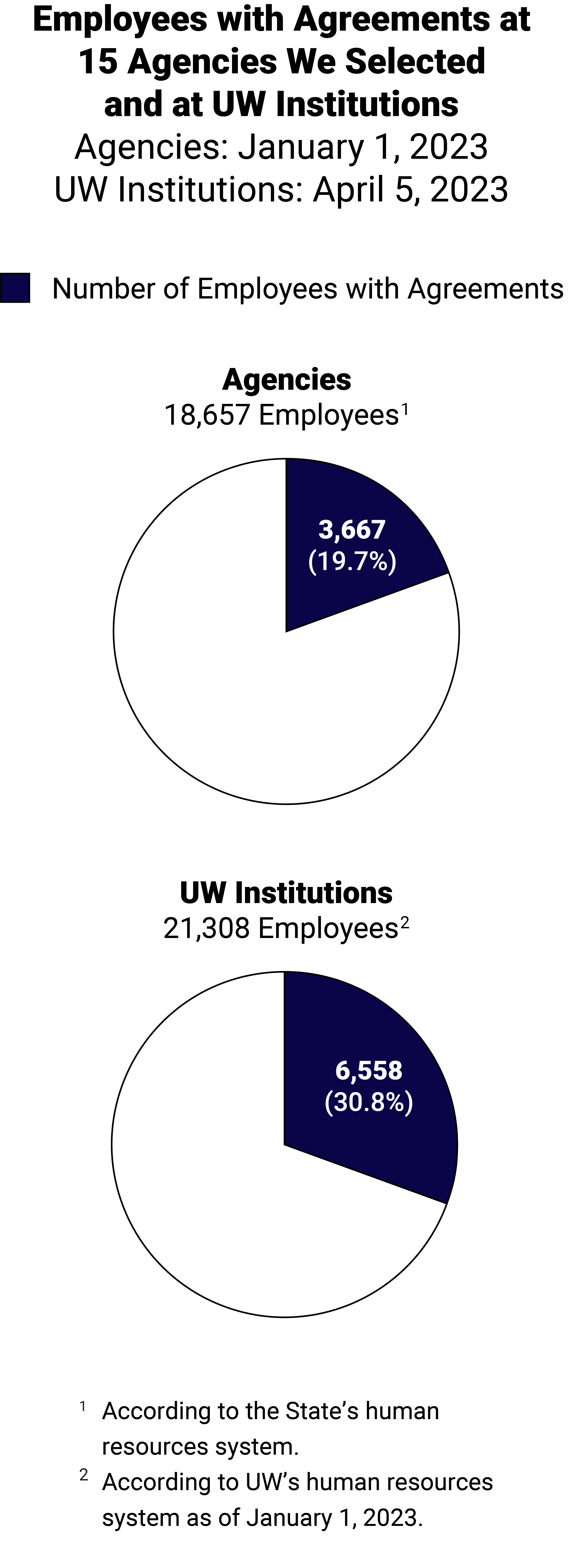
The precise extent to which employees worked in the office was not known. Therefore, we used the available data to analyze the extent to which employees teleworked.
We determined the extent to which permanent and project employees used their key cards from January 1, 2023, through June 2, 2023, at certain state office buildings where they were headquartered, according to the State’s and UW’s human resources systems. We found that:
- 3,439 agency employees used their key cards at four buildings an average of 1.3 days per week; and
- 186 UW System Administration employees used their key cards at two buildings an average of 1.5 days per week.
The key card data indicate some employees may not have worked in the office as frequently as expected, based on their agreements.
We determined the number of employees who resided two hours or more away from their headquarters, which are their permanent worksites, and were expected to work at their headquarters three days or more per week. We found that as of January 1, 2023:
- 388 agency employees resided two hours or more away from their headquarters, including 148 employees expected to work at their headquarters three days or more per week; and
- 780 UW employees resided two hours or more away from their headquarters, including 657 employees expected to work at their headquarters three days or more per week.
We question whether the 148 agency and 657 UW employees worked in the office as frequently as expected, based on their agreements.
Statutes prohibit agency employees from being reimbursed for expenses incurred while traveling from their residences to their headquarters, and UW System Administration policies prohibit UW employees from doing so. The State Compensation Plan and UW System Administration policies indicate the method for calculating reimbursement amounts for employees who travel from their residences to worksites.
We reviewed expenditure data for all travel reimbursements that were associated with expenses incurred in 2022 and paid to employees who on January 1, 2023, resided more than four hours from their headquarters, in states not contiguous with Wisconsin, or outside of the U.S. We found potentially ineligible travel reimbursements, including:
In July 2023 and August 2023, we visited selected offices of 15 agencies and UW System Administration six times each in order to determine the extent to which workstations were in use. We found:
- the average proportion of workstations in use ranged from 34.5 percent to 0.0 percent at 15 agencies in four state office buildings; and
- an average of 31.1 percent of workstations were in use at one UW System Administration building.

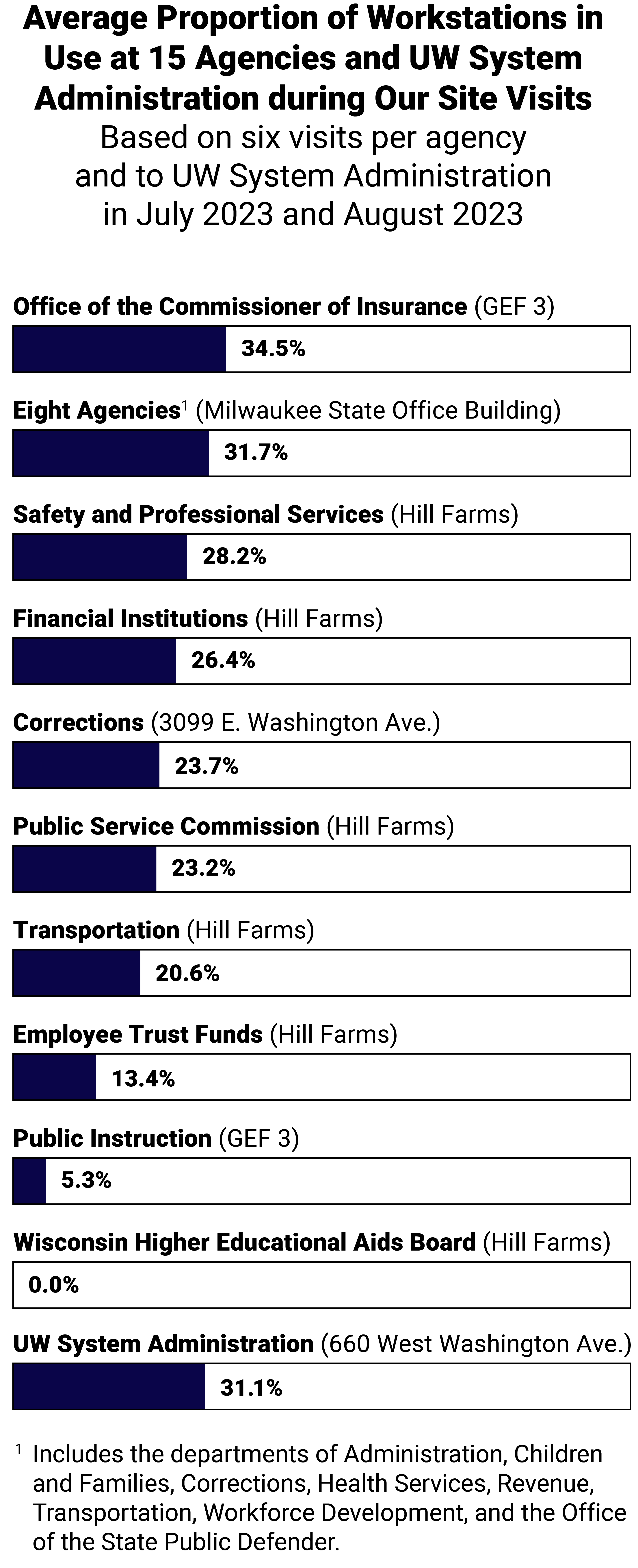
We determined the extent to which permanent, project, and other types of employees used their key cards. We found that from January 1, 2023, through June 2, 2023:
- employees at 12 agencies used their key cards at buildings where they were headquartered an average of 1.9 days or less per week; and
- UW System Administration employees used their key cards at two buildings where they were headquartered an average of 2.6 days or less per week.
Employees may not use their key cards on a given day if, for example, they work at locations other than their headquarters or enter buildings in groups because one employee used a key card to open a door.
In May 2021, DOA released Vision 2030, which is a multiyear plan for consolidating state office space. At the time of our audit, UW System Administration had not developed a plan to consolidate office space.
Space utilization measures the extent to which agencies use their space in buildings. We considered the amount of office space an agency anticipates it will have after consolidation occurs as a result of Vision 2030 and determined the proportion of this space that an agency used, based on employee use of key cards and our six site visits.
We found that additional consolidation of office space could be considered for the agencies we analyzed. For example, Vision 2030 indicates the Public Service Commission requested additional office space, but the key card data indicated it used the equivalent of 54.1 percent of this expanded space on the single day when the most employees were in the office during the five-month period of time we analyzed, and our six site visits indicated it used 26.2 percent of this expanded space.
Although UW employees began to telework more frequently in spring 2020, UW System Administration subsequently renewed its leases early for two buildings, including 660 West Washington Avenue. The key card data indicated UW System Administration used the equivalent of 52.2 percent of this building’s space on the single day when the most employees were in the office during the five-month period of time we analyzed, and our six site visits indicated it used 45.3 percent of this space.
Consolidating office space has significant financial implications for the State and UW System. DOA’s office space standards apply to most office buildings the State owns or leases but not to UW System buildings. The standards indicate employees who typically work in the office three days or more per week may be assigned their own workstations, but employees who typically work in the office less frequently should use shared workstations.
DOA’s Vision 2030 provides a framework for consolidating office space but has limitations. For example, we found that DOA did not independently assess how agencies calculated their office space requests or whether agencies calculated their requests appropriately.
We recommend DOA:
- require all agencies to provide it with accurate information on the extent to which employees work in the office;
- ensure all agencies follow its office space standards and assign workstations only to employees who typically work in the office at least three days per week;
- independently assess information provided by agencies that are planning to consolidate their office space; and
- help agencies to determine the amount and types of office space to request.
We recommend UW System Administration work with the Board of Regents to:
- develop an office space consolidation plan; and
- require UW institutions to collect accurate information on the extent to which UW employees work in the office.
Managing IT risk is critical to ensure IT security for state agencies and UW System, which retain confidential and sensitive data such as personally identifiable information. When employees telework, it is important to maintain appropriate IT controls to mitigate the risk of inappropriate access to these data.
Statutes require DOA to oversee and monitor IT operations of executive branch agencies. In fiscal year (FY) 2014-15, we first recommended DOA develop and implement IT policies and standards and oversee and monitor agencies. Since then, we continued to identify IT security concerns and make recommendations to DOA, including in report 20-11 and in report 22-26.
In this audit, we found 36 concerns related to data classification and encryption, security awareness, identification and authentication, and audit logging at the 10 state agencies we reviewed. We found concerns at each of these 10 agencies.
UW System Administration is responsible for establishing systemwide policies, including for information security. In FY 2014-15, we first recommended UW System implement a systemwide information security program. Since then, we continued to identify IT security concerns and make recommendations to UW System Administration, including in report 20-10.
In this audit, we found eight concerns at the five UW institutions we reviewed. We found concerns at each of these five UW institutions.
We determined that the detailed results of our reviews were too sensitive to communicate publicly. However, we recommend DOA and UW System Administration address the concerns we found and report on their progress of doing so to the Joint Legislative Audit Committee.
Please see the complete list of our recommendations on our website. We also provide the Legislature with one issue for its consideration.
To help determine the appropriate extent to which the consolidation of the State’s office space should occur, we provide several questions pertaining to telework, space management, and risk management that may be considered in the future.




